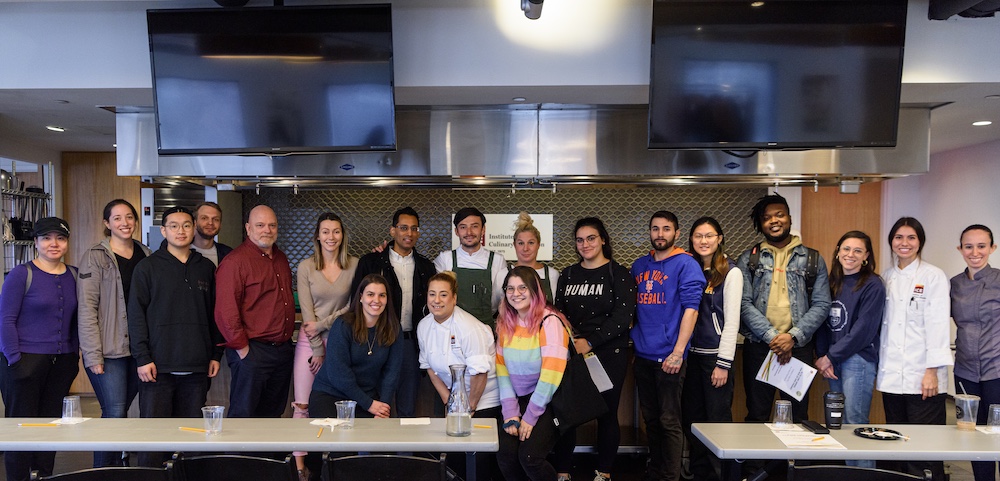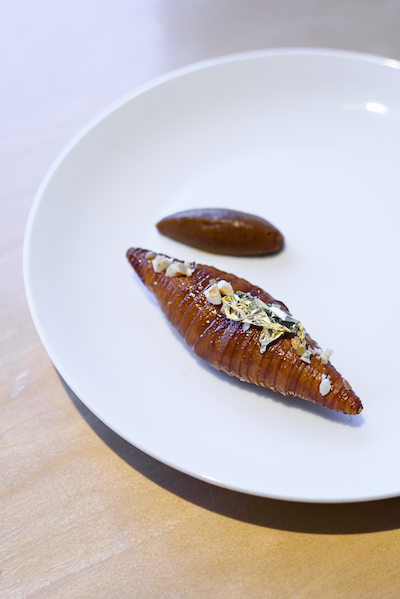The executive chef of Hiša Franko (No. 38 on the 2019 World's 50 Best Restaurants list) introduced ICE students to Slovenian culture, Soča Valley flavors and two of her signature dishes using terroir and unique techniques. Chef Ana was named the World’s Best Female Chef in 2017 and starred on Netflix’s “Chef’s Table,” season 2 episode 5.
You can cross Slovenia from east to west in three hours, Chef Ana divulged while introducing the nature of her country, which is bordered by Austria, Croatia, Hungary and Italy. “We’ve been a part of six countries,” she said. “Immense identities surround us. We are one of the most, if not the most, diverse countries in the world.”
Chef Ana explained how history, from socialism to migration, impacted Slovenian cuisine, which combines Italian, German and Balkan influences. “Geography for food is very important … Borders have divided families and communities, but a border doesn’t stop culture or food.”
She calls Slovenian people and food such a melting pot they’re “undefinable” — that was until she took the helm at Hiša Franko. A self-taught cook-turned-chef, Chef Ana never studied, staged or even helped her parents with dinner.
“I jumped in the water without knowing how deep it is,” she admits of the first night she ran the kitchen for service in 2002. “I’m in a constant doubt, but doubting is so important. Never think you’ve reached your goal. When you reach your goal you stop working, and cooking is a living thing.”

Chef Ana was inspired by seeing the world and found her culinary voice upon returning home. “When you travel, you start thinking for yourself,” she said to students at her Elite Chef demo. Now she travels up nearby mountains to source butter from shepherds, works with local fishermen for trout, forages and gardens.
Hiša Franko showcases global influences with coffee, spices and a staff from around the world, but the main ingredient in each dish comes from the environment surrounding the restaurant. “With the two dishes I’m preparing today, I would like to prove to you how important it is to keep your identity and be original,” Chef Ana said. “Walk around the world with your eyes open and use the techniques, but do not copy and paste.”

She and Sous Chef Leonardo (Leo) Fonseca began the demo with potatoes, a very traditional dish in Slovenia, with which she incorporates ricotta for locality and acidity, and hay, which historically represents preservation and transports today’s guests at the restaurant to the mountains where the cheese is made. They ferment the cheese with rock salt and hay for two years, resulting in a spiciness that the potato balances out.
When the team at the restaurant blends the local hay, the aromatic oils are so strong that they have to wear masks. So Chef Ana brought hay and cheese from Slovenia for students at ICE to smell and experience while she explained how to poke the potato so the essential oils can penetrate the vegetable. When the dish is served at Hiša Franko, guests break open the aromatic hay-crusted potatoes for an essence of the mountains, an idea that came from the tradition of cooking fish in a salt crust for preservation. At the demo, Chef Ana breaks one open for students to smell.
“The beauty of both of these dishes is they’re humble,” Chef Ana said while transitioning to her signature apple dish, for which she searches for the perfect tart, non-starchy variety in each destination where she travels.
“All of the other elements take time, a little bit of pain, skill and patience,” said Chef Leo. “For the guests, we call this dish ‘A Masterpiece.’ In the kitchen, we call it a pain in the ass.”
“We collect rosehips on a mountain,” Chef Ana explained. “It takes an incredible amount of time to pick them. We dress up in the worst things we have and throw them away because of the thorns. And it’s cold: Rosehips need at least one freeze to develop sugars.”
Slowly cooked in water, carefully de-seeded and dried, the rosehip is served with juniper, because the two grow together, and beeswax, which is difficult to work with while “incredibly aromatic,” and of course, full of terroir.

Chef Leo demonstrated extracting the entire flesh of an apple in a strip, which can stretch out to 1 meter, using a Japanese mandoline. He rolled the strip tightly with toothpick-like skewers in the shape of a croissant, injected rosehip puree inside, brushed a coating of cajeta on and torched the treat three times.
After the flesh is used for this dish, Hiša Franko freezes the remainder of the apple with sugar and cinnamon to make ice cream as a complement, which served alongside beeswax pastry cream, completes the masterpiece.
“Working so close with nature means you have to be creative and flexible,” Chef Ana explained. “We change six to seven courses on the menu a day. An ingredient can change based on a storm or the moon, and we need to make people happy. We have people traveling 10,000 kilometers to eat our food.”
And while getting to know a tiny country’s culture throughout 11 courses should bring happiness, Chef Ana aims for guest experience. “Local products are strong in flavor. You can have a memorable meal and not like every element,” she said. “Respect the territory, the seasons and your personality. That’s what makes food original.”
Experience more original food at the next Elite Chef demo, and find your culinary voice in our career programs.




